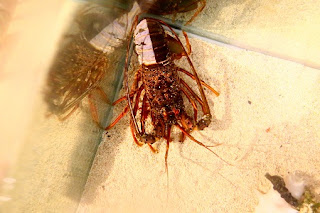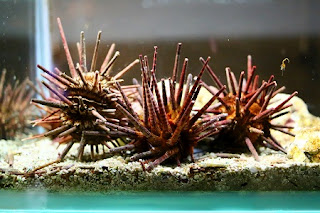Biological monitoring at Toba Aquarium, Mie prefecture
I visited Toba Aquarium to see biological impacts of Fukushima No.1 nuclear power plant accident. Though I have visited various places in Japan to see the health consequences of the accident, I have never found any effect against creatures in Japan.
Toba Aquarium is located in Mie prefecture. It is one of the world maximum grade scale aquariums. Toba Aquarium rears the most numerous species in Japan. From dugong, nowhere else in Japan, to "rare creatures", about 1200 species of popular and unique marine lives are gathered from the world.
The building is divided up between 12 zones by a species and habitat which can be explored at leisure. The mermaid sea zone is the only one in Japan, where you can see a real dugong. Sea lion performances are held in the performance stadium, and in addition, a variety of experience zones are offered, including sea beast kingdom, coral reef diving, the sea around Ise Shima, the sea around Japan, etc.
Generally speaking, marine creature's growth is so fast than human beings that they are more sensitive to radioactive materials of the environment than us. So I visited Toba Aquarium to see effects of the accident against creatures which are grown up by Japanese food and water. Fortunately, I can see them grown up safely and I cannot find any impact of the accident. It seems that there is no problem for childbirth and child-rearing in Mie prefecture, Japan.
Posted by Yoshitaka Kiriake from Japan on November 24, 2015.
三重県の鳥羽水族館は飼育種類数が日本一を誇る水族館です。珍しいジュゴンやアフリカマナティに会えます。色彩変異の紅白イセエビやマナマコもいました。
These pictures were taken on September 2015.
Japanese spiny lobster (color variation)
Panulirus japonicus
紅白イセエビ (色彩変異)
American Beaver
Castor canadensis
アメリカビーバー
Toba Aquarium
鳥羽水族館
About Toba Aquarium
English
Japanese
Google map
Sea angel (Clione limacina)
クリオネ、ハダカカメガイ
Seaweed pipefish ; Syngnathus schlegeli (Lt) and Heptacarpus geniculatus (Rt)
ヨウジウオ (左) ; コシマガリモエビ (右)
Japanese common sea cucumber (color variation)
Stichopus japonicus
紅白マナマコ (色彩変異)
Red-streaked box crab
Calappa lophos
トラフカラッパ
Noble file clam
Ctenoides ales
ウコンハネガイ
Eucidaris tribuloides
タイセイヨウマツカサウニ
Dugong
(Dugong dugon)
ジュゴン
Bolinopsis mikado
カブトクラゲ
Weedy Seadragon
Phyllopteryx taeniolatus
ウィーディーシードラゴン
Bichir
Polypterus endlicheri endlicheri
ポリプテルス・エンドリケリー
Horseshoe Crab
Limulus polyphemus
アメリカカブトガニ
Marron (color variation)
Cherax cainii
マロン (ブルー個体)
Red swamp crawfish
Procambarus clarkii
アメリカザリガニ
Finless Porpoise
Neophocaena phocaenoides
スナメリ
Mandarin Dogfish
ヒゲツノザメ
Freshwater angelfish
Pterophyllum scalare
エンゼルフィッシュ
Electric Eel
Electrophorus electricus
デンキウナギ
West African Manatee
Trichechus senegalensis
アフリカマナティー
Red-belted Anthias
Pseudanthias rubrizonatus
アカオビハナダイ
Stocky anthias
Pseudanthias hypselosoma
ケラマハナダイ
Bicolor angelfish
Centropyge bicolor
ソメワケヤッコ
Foxface
Siganus unimaculatus
ヒフキアイゴ
Sailfin tang
Zebrasoma veliferum
ヒレナガハギ
South American Sea Lion
Otaria flavescens
オタリア
Shinkansen
Japanese foods are good and safe.
Because of stricter food safety law by Japanese government, we have no worry about foods.
Ise lobster set meal
伊勢海老定食
Awabi no Sashimi
Abalone Sashimi
アワビの刺身
Fortunately I have never found any impacts by the accident among Japanese creatures. As far as I know, nobody has health problem which is caused by the accident in Japan.
Our Prime Minister Abe assures that "The situation is under control. The influence of the contaminated water is completely blocked within Fukushima. There are no health-related problems until now and there will never be health problems." He also said that "Tokyo is 250 kilometers away from Fukushima, and the kind of danger that you imagine does not exist in Tokyo. Tokyo is a very safe city."
As PM Abe said, Mie prefecture is very far away from Fukushima, people in Mie have no concern about the nuclear power plant accident. People in Mie prefecture have already forgotten the accident, because they think radioactive materials cannot reach there.
We know there is no problem for child birth and child rearing in Mie. So people in Mie are living without any concern about the accident.
I continue to visit various places in Japan to see the effects of the accident, because I can meet various creatures which are more sensitive to radioactive materials from the environment. It is important to see their health for our safety.
公衆衛生ネットワーク
Public Health Network in Japan

































0 件のコメント:
コメントを投稿